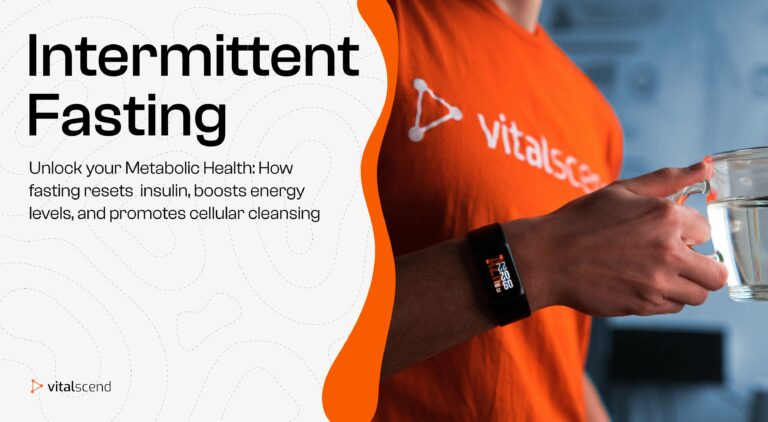The Science of Fasting – 14 Studies
Fasting is one of the most popular methods of modern-day dieting. It is about extending the non-eating window, which supposedly comes with beneficial effects on metabolic health. That’s good news for anyone who likes fat loss, mental clarity, and more energy.
However, with the emerging fad diets, fasting has been one of the fastest-growing regimes of eating, promoted amongst health experts. So rigorously, that fitness experts promote eating a ton of junk food in a shorter timespan as healthy. To be clear, it’s not.
And this is when science takes a backseat to marketing, which is bad because while fasting on its own can provide numerous benefits, it is very unlikely to do so if we’re eating unhealthy foods. Thus, it’s essential to learn how to do it right and understand the science-backed benefits and mechanisms.
Hippocrates, the father of modern medicine, said “To eat when you are sick, is to feed your illness.” It seems, after all, the ancient Greeks knew fasting had its benefits, although science wasn’t as developed.
What Is Fasting At Its Core
At its core, fasting is the practice of abstaining from food [calories] for a set period of time. While fasting has been used for centuries as a religious and spiritual practice, it has also been embraced by the scientific community for its numerous health benefits.
By depriving the body of calories it can start using energy in a different way. By doing so, it can remove dysfunctional cells, reduce information, and burn fat for fuel. Although it seems very simple, changing the way the energy creation mechanisms in the body work, by calorie deprivation, can do wonders for the body.
It acts in a way as an internal detox, stimulating something called autophagy. That stands for self-eating. Numerous physiological processes occur, which cleanse the body in and out. Why do we need this? Nowadays, food isn’t a scarce resource anymore. Obesity trends are growing parallel to our sedentary lifestyle. There are more convenient, empty-calorie, comfort foods around us, than ever before. The body needs a break from digesting food, running constantly inflamed.
DISCLAIMER
Despite the numerous potential benefits of fasting, it’s important to consult with a healthcare professional before starting any fasting protocol. Fasting may not be suitable for everyone, and it’s important to listen to your body’s needs and hunger cues.
Science of Fasting
Fasting works by inducing mild cellular stress, which promotes adaptive responses that can enhance the cells’ stress-coping mechanisms. Just as exercise damages the muscle, only to regrow it back stronger, so does fasting stress the cell, so it can regenerate faster. (1)
One important point to understand before digging deep into fasting research is that its mechanisms aren’t that dissimilar from caloric restriction or ketosis. Short-term caloric restriction and ketosis have [just as fasting] been shown to improve weight management and cardiovascular health, specifically insulin sensitivity and mitochondrial function. Due to the similar physiology behind the three, we can draw a parallel and find comparable benefits between them. (2)
When we reduce the frequency and quantity of glucose ingestion, the body taps into fat as an energy source. This happens in caloric restriction, just as in fasting, or keto diet. Ketone levels rise, and the body starts running off fats. (3)
1. Weight Loss
Weight loss has been the most popular topic related to fasting. Still, numerous questions are left unanswered. Does fasting actually contribute to weight loss, and how so? Is it a magic diet allowing us to eat junk food and then take a break, while still losing weight? In other words, is timing the only important component?
No, fasting by itself won’t speed up weight loss if the amount of calories eaten is over the amount of calories burnt. However, it is a very practical way to go on a caloric deficit. Additionally, fasting’s benefits on metabolic health can enhance the energy-creation mechanisms and appetite-controlling hormones, which can make weight loss much easier.
Caloric restriction or undernutrition without malnutrition is the only consistent approach that prolongs survival in humans and animals. In other words, fasting on his own doesn’t just bring the benefits. It’s partially the caloric restriction people partake in during fasting. (1)
A systematic review of 41 articles with 27 trials in overweight and obese patients shows intermittent fasting aids in weight loss. Participants lost around 0.8 percent to 13% of baseline weight without adverse effects. (4) These results are comparable to calorie restriction and additionally, participants improve their glycemic control.
Fun Fact
Optimizing the energy-producing machinery indirectly leads to weight loss. Why? Because more energy means we need less food to sustain life. We become more efficient at producing [extracting] energy from the calories we ingest.
2. Adipose Tissue & Thermogenesis
During exercise, core body temperature increases so much that our bodies dissipate heat through sweating. The more calorie-burning activities we do, aka exercise through which we sweat, the more weight will lose. However, with cold showers being the new trend, this equation has tipped. Increasing brown fat, which is more metabolically active and burns more calories, can tip the scale to weight loss. While this is known to be stimulated through cold exposure, research confirms that fasting can do this as well.
Fasting promotes thermogenesis through white adipose tissue browning, increasing the expression of thermogenesis genes. This in turn increases energy production through oxidative phosphorylation, ultimately counteracting hyperlipidemia and dyslipidemia. (5) (2)
Visceral adipose tissues act as an endocrine organ via adipokine secretion. The quality of this fat will determine the inflammation in our bodies. Adipocines can be pro-inflammatory-like leptin or anti-inflammatory like adiponectin. These play crucial roles in regulating body weight, food intake, and energy expenditure. Adiponectin acts on various receptors, influencing fatty acid oxidation and glucose metabolism. The beneficial effects of intermittent fasting include improvements in the leptin/adiponectin ratio, sensitivity, and appetite control. (2)
One prominent theory links increased adiposity to chronic inflammation, leading to insulin resistance. (6) Intermittent fasting has the potential to mitigate adiposity and insulin resistance through reduced caloric intake and metabolic reprogramming. (7)
Conclusion
Intermittent fasting can result in weight loss due to an unintentional caloric deficit. By reducing inflammation, improving adipose tissue quality, and fatty acid oxidation it can lead to favorable effects on metabolic health, energy expenditure, and appetite control.

3. Metabolic Health
Metabolic health is all about the effective use of calories to produce [ATP] energy. If one’s insulin can’t take glucose and transport it, the body runs into a metabolic deficit. It needs more calories to sustain life but uses them inefficiently. This leads to metabolic syndrome.
Metabolic syndrome is a combination of metabolic abnormalities like central obesity, insulin resistance, hypertriglyceridemia, and increased cholesterol. (8) It is directly linked to all the obesity-related diseases. Estimates suggest that MetS prevalence in the United States ranges from around 22 to 35%. 35% of US adults exhibit prediabetes and the incidence of type 2 diabetes globally correlates with the rising prevalence of obesity projected to be around 75% by 2030. (9) (10) (11) (12) (13)
Fasting induces a metabolic shift between glucose and fatty acids, which can positively impact metabolic health. It’s like turning a metabolic switch button on, where the body stops using glucose and starts burning fatty acids for fuel. These processes trigger AMPK pathways, autophagy, and mitochondrial biogenesis, known to promote health. (2)
A reduced energy intake through intermittent fasting can then therefore lead to a prolonged decrease in insulin production, contributing to better insulin sensitivity and glycemic control. (14)
During fasting, just as in ketosis or caloric restriction, there is glycogen depletion in the liver. This leads to the mobilization of fatty acids [breakdown of triglycerides into fatty acids and glycerin] which increases ketone production, activating pathways linked to longevity. (2) (5)
Fasting can lead to a reduction in LDL cholesterol (20-25%), total cholesterol (10%-21%), and triglycerides (14%-42%), improving lipid profile and cardiometabolic health. (15)
Conclusion
Fasting, by reducing the frequency of glucose ingestion can allow the body to tap into fat stores for energy. This metabolic shift causes numerous advantageous physiological effects, potentially resulting in better insulin sensitivity, glycemic control, and lipid profile.
4. Inflammation
Increased inflammation and oxidative stress directly correlate with faster aging. Overeating or eating large volumes of food results in increased inflammation. Fasting, by reducing the frequency of dietary intake allows the body to clean itself.
Extended fasting during Ramadan has been shown to reduce inflammation, attenuate pro-inflammatory cytokines, modulate immune cells, and enhance circulating glucose levels. Studies in animals and humans suggest that fuel selection is altered, metabolism efficiency is improved, and oxidative stress is reduced during extended fasting. (16)
Fasting can reduce inflammation activations amongst numerous health conditions including neurological, metabolic, and cardiovascular diseases, inflammatory diseases, pulmonary, and gastrointestinal conditions. Out of the different types of fasting, time-restricted eating or intermittent fasting was the most effective in regulating inflammasomes. (17)
An experiment of 12 months of intermittent fasting in healthy males caused significant reductions of insulin-like growth factor 1, fat mass, body mass, and testosterone levels compared to a normal diet. Inflammatory markers such as interleukin 6, interleukin 1β, and tumor necrosis factor α were also improved. (18)
Since obesity is linked to low-grade inflammation, weight loss through fasting can reduce systemic inflammation. While short intermittent fasting of 4-10 hours didn’t produce significant effects on inflammatory factors, alternate-day fasting reduced CRP concentration. (19) (20)
Conclusion
Intermittent fasting has shown potential in alleviating inflammation, indirectly by reducing weight and frequency of dietary intake. Research shows a trend toward lowering inflammatory factors (IL-6, IL-1β, TNF-α) with fasting.

5. Brain and Cognition
The brain is composed of 60% plus fats. Fatty acids are essential components that support cognition and brain function. But despite the brain’s substantial energy demands, it mainly uses glycogen stored in the CNS, which makes it dependent fast-energy from carbohydrates. Alternative energy-rich substrates include ketone bodies, lactate, and medium-chain triglycerides [MCT]. (21)
During fasting orchidosis, we deplete glycogen levels and start mobilizing fat for fuel. The brain starts using ketones for energy. This energy is clean and efficient for the brain, allowing for what experienced fasters call mental clarity or relaxed alertness. The keto brain is less hyperactive and distracted.
Beyond energy supplies ketones and BHB can regulate numerous neurotrophic factors like brain-derived neurotrophic factor [BDNF] associated with mitochondrial biogenesis, synaptic plasticity, and cellular stress resistance. (22)
Studies suggest that intermittent fasting induces several molecular and cellular adaptations in neurons, which, overall, enhance cellular stress resistance, synaptic plasticity, and neurogenesis. (21) This ties directly to the theory that overeating drives inflammation and metabolic diseases that aggravate the development of neurodegenerative conditions.
This is why fast thing is said to delay brain aging. Improving certain factors for the most common neurodegenerative diseases can ward off neurodegeneration and potentially improve cognitive function.
For example, it helps reduce amyloid plaque buildup and inflammation in the brain. The primary cause of Alzheimer’s disease. Then it enhances BDNF and dopaminergic function, improving retention of motor skills, very important for someone with Parkinson’s. Finally, by improving gut microbiota richness and lowering T Lymphocyte levels, it potentially can reverse multiple sclerosis progression. (23)
Conclusion
Fasting can hit the metabolic switch in the brain, from using glucose to using ketones for energy. This comes with a myriad of potential benefits that aid cognitive function and ward off neurodegeneration.
6. HGH and Longevity
Human growth hormone is one of the most important hormones for anti-aging and longevity. Fasting, in numerous studies has been shown to aid in the increase of HGH. However, many experts confuse this with the anabolic pathway, which is far from the truth, fasting actually reduces mTOR activation and anabolic pathways.
Acute nutritional status influences pulsatile growth hormone secretion in humans. During periods of fasting or starvation, human growth hormone levels can skyrocket. This is believed to be due to HGH’s role in preserving muscle mass and promoting fat utilization for energy, which is extremely important during periods when food intake is limited.
Notably, a 5-day fast results in a substantial increase in discrete GH pulse frequency, 24-hour integrated GH concentration, and maximal pulse amplitude. (24)
The restriction of proteins, amino acids, or sugars can profoundly impact hormone and growth factor levels, including growth hormone, IGF-1, and insulin. These, in turn, regulate intracellular signaling pathways, cellular damage, aging, and multisystem regeneration. Both intermittent fasting (IF) and periodic fasting (PF) exhibit both acute and long-term effects on these hormones. (25)
The HGH/IGF-1 anabolic pathway is downstream which is responsible for promoting anti-aging and age-related diseases. This is how nutrient restriction has emerged as a potent modulator of hormone and growth factor levels, contributing to the delay in the onset of age-related disease and extension of lifespan. (25)
Conclusion
Nutrient restriction can increase the levels of HGH, an important hormone that supports anti-aging pathways. The catabolic reaction modulates pathways related to cellular damage, signaling pathways, and inflammation.

Fasting Limitations, Challenges & Potential Risks
Fasting has gained widespread popularity as a means of improving health and well-being, but it is not without its limitations. While further research is necessary to fully comprehend the mechanisms behind the potential benefits of fasting, it is clear that fasting has the potential to improve human health and well-being through a variety of mechanisms.
That being said, there is a huge difference between fasting the right way and jamming up your fast food in a 4-hour window. Healthy fasting emphasizes eating nutrient-dense foods within a consistent eating schedule.
The circadian rhythm’s role in balancing anabolic and catabolic activities is crucial. It controls multiple aspects of metabolism such as protein and lipid synthesis, glycolysis, and mitochondria activities. Disruptions to this daily rhythm can adversely affect the metabolic system, leading to increased oxidative stress, heightened insulin resistance, and impaired hormonal secretion. (26)
Not Suitable for Everyone
Drug Interaction
Hunger & Low Energy
One of the main limitations of fasting is that it may not be suitable for everyone. Those with certain health conditions, or pregnant women, individuals with a history of eating disorders, and those who are underweight may not be good candidates for fasting.
Fasting may also not be safe for those who are on certain medications, such as insulin or blood pressure medications. It’s important to consult with a healthcare professional before starting any fasting protocol to determine if it is safe and appropriate for you.
Another limitation of fasting is that it can be difficult to stick to, especially for those who are not used to going without food for extended periods. Hunger, cravings, and low energy levels can all be potential challenges when fasting. It’s important to be prepared for these challenges and to have a plan in place to deal with them.
Conclusion
The science of fasting showcases its potential benefits in metabolic health, cognition, and anti-aging. Primarily, fasting acts as a mild stressor to the cell, which improves it’s resillience. Reducing dietary intake has similar effects to caloric restriction or ketosis, dependent upon the shift in energy source from glucose to ketones. This kickstarts numerous pathways related to fat loss, anti-aging, energy production, and better glycemic control. Overall, fasting is a viable tool that hits the reset button on one’s metabolism, promoting a sort of internal detox.








